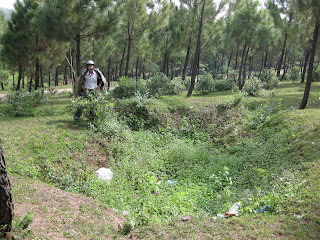


My body rolls in time with the loping slow stride of graceful legs, carrying us along on great padded feet through scrubland and a wind farm (how 21st century, each one labelled SUZLON 1250 in letters ten feet high), rolling, stepping, as the sun rises in its broad arc, I envision the lime green cacti topped by celebrant turbans of tiny red flowers, the branchy leafless bushes, through the densely-lashed eyes of the great, slow beast named Kadhu that bears my weight with such aplomb.
Traditional geometric patterns are clipped into the fur of their flanks and tails. Long-haired black goats and black-headed sheep wander about, lost lambs complain to their mothers, climbing up on a bush to reach the fresh-growing shoots on top. Our camels eat these too - distinguishing them, I think, by color - snatching them on the hoof by swinging their powerful necks to the side.
Revenge of Kadu
Kadhu and Amanda's camel, Patang, have a feud going on, apparently triggered by their mutual recent interest in a girl-camel some days ago, such feelings resulting in an incident in which Kadhu drew first blood, sinking his teeth into the taller, but slender and generally more graceful animal. Patang is in fact a gorgeous creature, lithe and smooth, a cush, photogenic ride for Amanda, wheres I am astride a testosterone-addled beast. For their fighting they are both now in a boys-only group (note: who knew camels pee backward?), so the hormones build and build. Chuchi, our third and otherwise quite predictable animal, attempts to run off with any close-passing caravan containing females.
At irregular intervals Kadhu makes a deep, grunting, burble from deep inside himself, then rears back his head, opens his foamy mouth, and unexpectedly lols a livid, massively-inflated tongue, bouncing it on the spit-frosting of his lips, culminating in a sustained plopping sound which Amanda describes as a mixture of The Bog of Eternal Stench in the movie Labyrinth and Jabba The Hut. To camels this is in fact a sexy and virile sound, a "come hither" emitted spontaneously when health and testosterone reach certain levels, when female camels are present, presumed, or hoped-for.
Amanda, on Patang, followed behind me. After a few of these outbursts, Patang decided to give his own editorial on the subject. At a moment Amanda of wasn't paying attention, Patang made his move. According to her:
"When I opened my eyes from the sound of camels wailing and grunting, I immediately saw that Patang had buried his head in Kadu's ass; a few seconds later, as I pulled Patang back, I could see the wetness of Patang's saliva on Kadu''s balls. By Kadu's cry I was sure he had been chewing on them."
From my point of view, what happened was, Kadhu came to a lurching halt and reared his head his head back over my shoulder with great and sudden indignation, scaring the crap out of me.
This happened early on, so for the rest of the trip I was able to apply the knowledge that camels are kinky, mean, and get right to the point.
A much of their body language is similar to that of horses, another furred ungulate of similar stature, this is only due to the mere physics of such a body; in personality they are more like giant, hoofed monkeys.
Warning: if you were made queasy by this last bit of camel antics, you might want to skip this section.
After this, Kadu had his eye on Patang, even though he continued to emit his characteristic grunt-burble-lol from time to time; and when they were feeding and being de-saddled at camp that sunset, they apparently met eyes, at which point Kadu made a gesture of his own.
Rearing up, he stood with his rear legs straight but distinctly spread, then began to simultaneously urinate and defecate, spinning his club-like tail to send these offerings in every direction, while looking meaningfully at Patang. After this, Patang watched Kadu like a hawk. When we all, out of range, laughed our own asses off (only in my case, literally, see below), I could see how the observation of camel antics might provide some insight to the normally-hidden parts of human nature, as well as a lot of entertainment in an otherwise serene place.
Now that we've eliminated the squeamish folks, I can tell you a bit more of my personal experience on this safari. I set out with a troubled tummy, and in the course of ouyr two-day and one long night adventure, crouching underneath innumerable spiny bushes, I lost all the contents of my gastro-intenstinal tract to explosive diarrhea, with releases of gas comparable in volume and odor to those of the camels.
This experience, in combination with the resulting diaper-rash rubbing on the back of a robust, sexually-frustrated animal, taught me one unexpected fact likely to be of help to future travellers: that when in the saddle, it is a comfort to wear multiple pairs of underwear, regardless of whether you have other reasons for doing so.
Despite this distraction I had a great time, and the guides were kind . I recovered fairly quickly by eating a lot of yogurt and porridge, re-building my intestinal flora with the tougher Indian ones, and I haven't gotten sick since (knock on wood)...


















